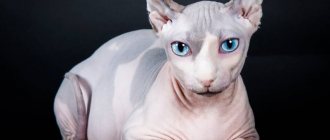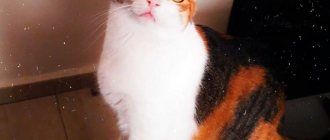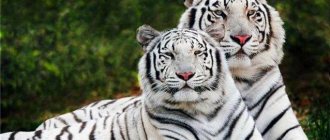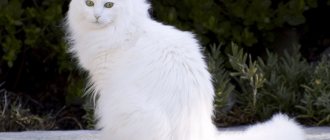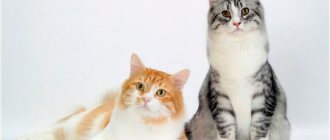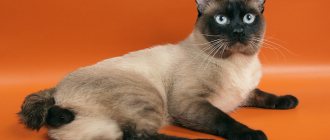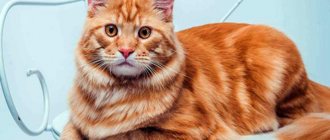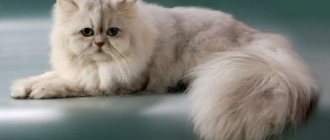What is tortoiseshell color
“Tortoiseshell” is any cat whose coat color combines 3 shades. In most cases it is black, white and red, regardless of which one is dominant. But it’s not just the combination of these colors that matters.
With a tortoiseshell color, the colors are not presented separately, for example, in the form of spots, but are mixed together, forming an intricate, very unusual pattern. When there are 3 colors scattered in the form of independent spots, this color is called tricolor.
Calico cat breeds
You need to understand that a tortoiseshell cat is not a breed, but a color identification. Often, not only short-haired representatives have a tricolor, but also, for example, a long-haired Persian. It is impossible to find a British or Scottish tricolor; occasionally you come across a bicolor, but a purebred murka is always welcome.
The breeds that most often have a tricolor color are:
- Maine;
- Manx;
- Persian;
- Siberian;
- exotic tortoiseshell cat (if the kitten’s mother is “red” and the father is “black marble on silver”);
- Turkish van;
- Neva Masquerade;
- Japanese/Kurilian bobtail;
- Norwegian forest;
- Angora.
Games of genetics or how the tortoiseshell color came about
The tortoiseshell color has one amazing feature - such an unusual pattern on the coat is characteristic exclusively of females. It is almost impossible to meet a cat with a variegated, multi-colored color, although such a possibility cannot be completely ruled out. The reason for this is a genetic mutation inherited by female kittens from their mother cat. However, such a mutation causes serious difficulties in reproduction.
Genetic features that determine color:
- The chromosomes that determine the sex of an animal are X and Y. XX is a cat, XY is a cat.
- Chromosomes that carry information about color: O - red, o - black.
- The Y chromosome does not carry information regarding the color of the coat; it does not have genes for either red or black colors. And the X chromosome contains only jet black or red shades. For this reason, cats with XY are extremely unlikely to be born with a tortoiseshell-colored coat. For every 3,000 cats with an unusual pattern, there is only 1 male.
Color options in cats with XX chromosomes:
- XO + XO = pure red color;
- Ho + Ho = absolutely black;
- XO + XO = tortoiseshell pattern.
It is not possible to obtain an unusual color with an interweaving of 3 basic colors through targeted selection. This is explained by the fact that the chromosomes have a chaotic arrangement and cannot be ordered.
It is unknown what will happen next, but at the moment, the tortoiseshell color of a cat is a matter of chance, which is not possible to predict, much less predict. Even a cat with a tortoiseshell color can give birth to kittens of a pure shade - black, white or red.
Solid colors
The group of solid (solid) colors of Persian cats is represented by the following colors:
- White - snow-white color without the slightest inclusions of another color.
- Black - coal-black, shiny, glossy in the light.
- Blue - pale slate-blue cats. In natural light, the wool shines beautifully with a silvery light.
- Red is a rich, bright and radiant red color.
- Cream - pale beige, pale fawn, pale milky.
- Chocolate (Chocolate) - dark brown warm shade.
- Lilac - pale lavender coat with a pale pink highlight.
Except for the solid white color, solid-colored Persians have coppery, orange eyes. In representatives of the snow-white breed, the iris of the eye can be either copper or dark blue. There are also cats with heterochromia: one eye is blue and the other is copper, and the coloring of the iris is of different intensities.
Persian cats of solid colors have coats that are evenly colored to the very roots in one single tone. As for the chocolate and lilac (lilac) colors, they were obtained as a result of crossing with representatives of the Himalayan breed.
Features of tortoiseshell colors: shades and main characteristics
The spotted coat color with the interweaving of 3 basic colors and the formation of an unusual pattern by them has its own subtypes depending on which shade is predominant:
- Black Tortoiseshell : Primary colors are black and red. In places where areas of red pigment are present on the fur, lightened stripes appear. Eye color – copper with a dark tint or dark yellow.
- Chocolate : the main colors are red and chocolate. Pigments have uniform saturation. Eyes - copper or yellow with an orange tint.
- Cinnamon : The base is red and a hint of cinnamon. The specificity of this type of tortoiseshell color is that world standards do not recognize it. The eyes are yellow with varying degrees of shade saturation.
All subspecies of tortoiseshell color are united by almost the same eye color in animals - yellow with different shades.
Types according to the drawing. Depending on what pattern is formed on the wool, there are:
- “Torti” – this type of color is also called “scaly tortoise”. The color of the wool resembles the scales of fish. The basic colors are black and red, represented by small spots located in relation to each other in a checkerboard pattern. It is extremely difficult to find such precise geometry. In most cases, multi-colored spots have a chaotic arrangement. However, the “tortie” color has another distinctive feature - the ratio between red and black is the same. The pattern is motley, the fur is speckled with hairs of different colors.
- "Calico". This type of color has other names - “patchwork” or “calico”. There are no individually dyed hairs, and entire areas of the fur are painted in different colors, usually red or black. The spots can be located separately, overlap each other, merging, or form groups. The most striking representatives with the Calico color are the British, Sphynx and Cornish Rex.
- Turtle on white. The peculiarity of the color is that the fur on the tummy and head in the chin area is white. The entire upper part of the fur has a tortoiseshell pattern, resulting in the impression that a tortoise shell was put on top of the white cat.
In a specific color, the base shades may be spotted or striped. It is extremely rare, but not excluded, that a combination of stripes and spots occurs.
Location of the drawing. Tortoiseshell color is divided into subspecies and depending on the location of the pattern:
- There is a solid turtle - spots of different colors are evenly spaced, as such there is no pattern or pattern.
- Patterned turtle - multi-colored spots form a pattern. These can be various spirals, circles and stripes. The longer a cat's fur, the worse the pattern can be seen.
Mr. Cat recommends: genetics of Tortie color and its varieties
The skins of cats of the "tortoiseshell" and "calico" colors are the result of the interaction of congenital and acquired genetic factors.
The primary coat color gene (B) is responsible for cinnamon, chocolate, brown and other similar shades. It may be masked by the codominant gene for orange (O), which is found on the X chromosome and has two alleles, orange (XO) and non-orange (Xo), producing red pheomelanin and black eumelanin pigments, respectively.
Typically, the designation "X" for a chromosome is taken from context, and alleles are designated only by uppercase "O" for orange or lowercase "o" for non-orange.
The Tortie and Calico cat colors are designated "Oo" to indicate that they are heterozygous for the gene.
The (B) and (O) genes can be further modified by the recessive dilute gene (dd), which softens the colors. For example, orange becomes cream, black becomes gray.
Different terms are used for certain colors, for example, gray is called blue or cyan, orange is also called ginger. Therefore, the tortoise shell color can be chocolate or bluish cream or similar shades based on the alleles for the B and D genes.
The cells of female cats, which like other female mammals have two X chromosomes (XX), undergo the phenomenon of X inactivation, in which one or the other of the X chromosomes is switched off randomly very early in development. The inactivated X is called the Barr body.
Cells in which the chromosome carrying the orange (O) allele is inactivated express an alternative non-orange (o) allele defined by the B gene.
Cells with the non-orange (o) allele inactivated express the orange (O) allele. Pigment genes are expressed in melanocytes, which migrate to the surface of the skin during later development.
In bicolored tortoiseshell cats, melanocytes appear relatively early, and the two cell types become intermixed, producing a characteristic mottled appearance consisting of a close mixture of orange and black cells, with occasional small diffuse patches of these same colors.
Bicolor tortoiseshell cat
In calico cats, a separate spotted gene develops in the coat color gene. It produces white, unpigmented patches by delaying the migration of melanocytes to the surface of the skin. There are a number of alleles of this gene that cause greater or lesser delays.
Calico Cat The amount of white is artificially divided into mitted, bicolor, harlequin and van, varying from an almost dark shade to almost completely snowy.
In extreme cases, the melanocytes do not reach the skin, and the cat is completely white (but not albino). In intermediate cases, melanocyte migration slows down because pigment cells develop late and have less time to mix with other tones.
Observation of calico cats shows that with a small amount of white in the color, the orange and black spots become more distinct, and with even more of it they are completely distinct. Each patch is a clone of cells derived from one original cell in an early embryo.
Tortoiseshell colors with a small number of snow spots are called “Cake plus white”; if there are a lot of light marks, then the term “calico” is used.
The tortoiseshell Calico color implies a calico cat. The word "Calicos" means "triple fur" in Japanese, and in Dutch the term "lapjeskat" (spotted cat) is used.
Also read the article about whether there are tricolor cats.
The factor that distinguishes "tortoiseshell" from "calico" coloration is the nature of eumelanin and pheomelanin, this is partly dependent on the amount of white due to the influence of the snow spot gene on the overall distribution of melanin.
A cat that has both the orange and non-orange gene, Oo, and a light to almost white marking will be a variegated mixture of red (cream) and black (blue), reminiscent of a tortoiseshell. A cat with Oo alleles with a lot of white will have huge, well-defined patches of red (cream) and black (blue), and this is called "calico."
With intermediate amounts of white, a cat may have a calico pattern, a tortoiseshell pattern, or something in between, depending on other epigenetic factors.
A true tricolor should consist of three colors: white, red (orange, yellow or cream) pheomelanin and black (brownish or gray (blue)) eumelanin.
The tricolor should not be confused with the natural gradations in the striped coat. The shades that are present in the pale tabby stripes are not considered a separate color.
- The basic "turtle shell" pattern has several different colors depending on the eumelanin color (locus B) and dilution (locus D).
- Thorbies display tabby patterns on both colors. Calico cats are also called calibers or tabicos.
The most common breeds that produce tortoiseshell kittens
An unusual tricolor color is found among representatives of some breeds:
- Persians;
- Siberian;
- Maine Coons;
- bobtails, regardless of subspecies;
- Turkish Angora;
- Cornish Rex;
- orientals;
- Scots;
- Norwegian forest cats;
- sphinxes;
- British.
Each of these breeds has its own characteristics of tortoiseshell color:
- Scottish and British - these breeds have a tortoiseshell color that is recognized as an international standard. But this does not give them an advantage. As practice shows, in most cases experts do not particularly favor representatives of these breeds with a bizarre coat color, and the likelihood that the animal will win at the exhibition is extremely low. But with the acquisition of these cats, on the contrary, it is a completely different story. British or Scottish tortoiseshells with this coat color are bought much more willingly, because cuter creatures simply cannot be found.
- Cornish Rex . Representatives of this breed are endowed by nature with such an unusual coat structure that any color on it will look truly amazing, and tortoiseshell color even more so. In combination with the unique grace and natural aristocracy that is felt in every movement of the cat, the tortoiseshell color adds even more impressiveness, classifying the animal as one of the world of “bohemia.” According to the breed standard, the color of their coat should not combine many shades, but tricolor is very welcome among experts.
- Bobtails . Regardless of the subspecies of the breed, the tortoiseshell color is recognized as a standard and is very welcome in individuals. However, these animals are popular not only due to their often unusual coat color. Bobtails are distinguished by high intellectual abilities and sociability. Unlike most cats, tortoiseshell bobtails are the best and easiest to train.
- Turkish Angora . It is commonly believed that these cats should be pure white as snow and have heterochromia (different colored eyes), however this is not entirely true. Among Turkish Angora cats, tortoiseshell coat colors are often found, which are of great value.
- Maine Coons . These cats attract everyone's attention with their large size and powerful torso. Impressive dimensions, proud, independent look and originality of character against the background of tortoiseshell color make Maine Coons especially attractive to cat lovers and even a little mysterious.
- Sphinxes . Surprisingly, but true: a breed such as the Sphynx, characterized by a complete absence of hair, can have a tortoiseshell color on its bare skin. Despite the non-standard appearance, the unusual lack of fur, “naked” individuals have recently become increasingly popular. The reason is the incredibly flexible, easy-going nature of the animals, their friendliness and affection towards the owner and all household members.
- Orientals . If in other breeds experts disdain tortoiseshell colors, although this is allowed by the standard, then in Orientals this color is only welcome. The breed standard allows for mixing 4 colors. These cats are incredibly smart, wise in an oriental way and, despite their outward independence and independence, they really love communication with people and even need it.
- Persians , exotics . These breeds occupy a leading position in choice as pets. Tortoiseshell color is not common among them, but it cannot be called rare either. Such an unusual combination of colors on long fur makes cats incredibly beautiful and attractive.
- Norwegian . Among all the breeds, it is generally accepted that the Norwegian Forest cat in this color looks the best. Thanks to the thick and long coat, the color transitions and intricate lines formed by them look especially elegant and unique.
Outbred murki.
Tortoiseshell colors are also found among yard cats.
What is most interesting is that it is among outbred murkas that animals with an intricacy of several colors in their coat color are most often found.
Cat character
In addition to the amazing colors, breeders note the unique character of tortoiseshell pets. Negative qualities include a sense of ownership towards the owner, sometimes it leads to physical attacks due to jealousy, violence and unpredictability. Independence and irritability are also not liked by breeders. Cats show their dissatisfaction in different ways: by loud meowing, growling and hissing.
Popular breeds with tri-color coat:
- American raccoons or Maine Coons;
- angora;
- lop-eared British;
- Scottish;
- Cymric;
- Norwegian forest;
- Cornish Rex;
- Siberian;
- sphinxes with velor, brush and flock wool;
- Japanese anurans.
Independence and pride are combined in one pet with sociability and playfulness, which is due to increased attention from humans. Beautiful color has always been highly valued, so the owner shows a good attitude towards the animal. The cat tries to reciprocate, tries not to upset the beloved family member. Turtles have extraordinary intelligence; they quickly learn simple commands and respond to their name.
If someone yells at the owner or uses physical force against him, the cat remembers this attitude and after a while can take revenge on the offender. The next time they meet, she will bite or scratch him. The pet loudly expresses its requests. Hunger, boredom and a feeling of discomfort are manifested by rather loud purring and constant rubbing against a person’s legs and arms.
Turtle animals are very active and mobile. They run around the house at night, conquer different heights, and throw small objects off tables and cabinets. They don't have enough games with rubber balls and mice. The owner needs to prepare for constant ambush attacks, frequent hand bites, and hair pulling with paws. If the animal does not receive enough attention, it will begin to cause harm: it will scratch wallpaper or furniture, tear curtains, and chew off wires. With these pranks he wants to show that he is lonely. You shouldn’t scold him for this behavior; it’s enough to just take care of your pet and show him your feelings.
Character and behavioral characteristics of tortoiseshell cats
Undoubtedly, it is not the color that dictates the character traits and behavior of an animal. Nevertheless, many years of observations have led to the conclusion that, regardless of breed, almost all cats with a similar spotted color have a number of common traits in character and behavior:
- Complaisance and friendliness . Animals are incredibly friendly and flexible in nature. The owner will always be able to come to an agreement with his pet, resolving any misunderstandings at the beginning of their occurrence.
- Pride and independence . Tortoiseshell cats, despite their close friendship with people, are distinguished by their independence and pride. Animals know exactly what they want, and nothing and no one will force them to do anything without their desire.
- Perseverance, bordering on incredible stubbornness , is another common character trait that is inherent in almost all tortoiseshell cats. They are so stubborn that they can persuade even a person.
- Tray training. There is one more feature that unites all “turtles” - despite the fact that cats are very smart and savvy, it is extremely difficult to accustom them to a litter box. Individuals with a tortoiseshell color may simply not agree with the place that the owner has allocated for them. It is useless to argue with these stubborn and persistent animals. It’s easier to move the tray to a place chosen by the cat.
However, at their core, tortoiseshell cats are very sweet, friendly creatures that are unlikely to cause any inconvenience to their owners and household members.
Himalayan colors
This group of colors cannot be called “pure” - it appeared as a result of crossing Persian and Siamese cats. Representatives of the Himalayan breed have color-point colors: the main background is light, and the dark color is concentrated on certain “points” - on the face, ears, legs and tail. In this case, the dark color can be either plain or striped (the group of Himalayan colors “lynx”, “lynx”). In all Persian cats of the Himalayan color, the color of the iris of the eye must be bright blue, pure blue (like Siamese). Other options are not valid.
Himalayan coats are represented by the following coat colors:
- Seal Point - “seal point”, dense, dotted Siamese color.
- Blue Point - blue Siamese color.
- Chocolate Point - chocolate Siamese color.
- Lilac Point - lilac Siamese color.
- Flame (Red) Point - fiery (red) Siamese color.
- Cream Point - cream Siamese color.
- Tortie Point is a tortoiseshell Siamese color.
- Blue-Cream Point is a blue-cream Siamese color.
- Chocolate-Tortie Point is a chocolate tortoiseshell Siamese color.
- Lilac-Cream Point is a lilac-cream Siamese color.
As for the Himalayan colors of the lynx (“lynx”) type, they are represented by the same 10 color variations from “seal point” to lilac-cream.
Signs and superstitions
Cats have always been surrounded by a veil of mystery and mysticism. From time immemorial they were considered guides to the other world and were often accused of aiding sorcerers and witches. Therefore, it is not at all surprising that such unusual, rarely seen animals with a tortoiseshell color are considered mystical. There are many signs and superstitions in different countries, but they all have one thing in common - a cat with a tortoiseshell color is a symbol of good luck:
- England . In this country, it is not customary to just give a tortoiseshell cat as a symbol of good luck and happiness. You must definitely give at least a small change for it, thus paying for further success, peace and love in the house. If a kitten with an unusual color comes into the house on its own, you also have to pay for happiness. At the intersection of 4 roads you need to put coins: it doesn’t matter what the amount is.
- Russia . In this country, any cat, regardless of breed and coat color, brought happiness and peace to the house. In Ancient Rus', cats protected the house from evil spirits, protected from evil spirits and enemies. It was especially good if the color of the animal’s fur matched the color of the owner’s hair. Then peace, comfort and love always reigned in the house, and good luck favored the household. In this regard, tricolor cats were considered universal. There are so many shades combined in the color of their coat that they will suit any hair color.
- Japan . In this country, cats are respected and loved by everyone, and animals with a tortoiseshell color are revered with greater honor. Figures with their image are placed near the entrance to each house, hoping that they will bring good luck. The Japanese prefer to have bobtails as pets, relying on the tortoiseshell color, because they protect the house and protect household members from evil spirits and bad thoughts of enemies.
- Arab countries . In the East, cats are held in special esteem, and they are more preferred as pets than dogs. Tortoiseshell cats protect against adversity, fire and theft.
- America . If in most countries tricolor cats are symbols of good luck, in America they are associated with money and material wealth. There is a belief in this country that if a tricolor cat comes to your house, it means that you can soon expect sudden enrichment. American bobtails are especially popular in the United States.
Also watch a video about tortoiseshell cats:
Signs with tortoiseshell cats
The tortoiseshell cat, due to its unusual and rare color, has always been endowed with magical properties. Different nations have many superstitions regarding this coloring of pets.
Magical properties of cats
Tabby color: examples of interesting combinations and cat breeds
The Japanese give calico-colored cats the property of bringing good luck and wealth. They are depicted as a Maneki-neko cat with a pearl in her paw. It also symbolizes homeliness.
Turks and other Muslims believe that if a tri-colored purr lives in a house, then fires are not dangerous for this home.
Interesting! Tricolor cats are considered good healers; they always try to lie down on a sore spot.
Does it bring happiness to the home?
It is believed that if you come across a tricolor kitten on the road, you should definitely take it home. Good luck will await the new owner in everything - both in his career and in his personal life.
There is also a wedding omen about such a cat. If she appeared next to the wedding car, then the spouses will live long and in perfect harmony.
A tortoiseshell cat is, first of all, a wonderful pet with an unusual appearance. Color does not significantly affect the character, so the kitten must be selected according to general breed standards. Well, you shouldn’t forget about lucky omens either, in case they come true.
Shaded colors
Red Cat or Dilute red are the main red colors of cats. But this group of colors also includes “shaded” red fur. In such cats, the upper part of each hair is colored, and the lower part is white. Animals with such fur also look very beautiful, as they look “golden” or soft cream. Such cats usually look somewhat lighter than pure red ones.
Kittens with this color first grow pure red hairs. But at a certain age, the animal’s “slower” gene, Inhibitor I, comes into play. As a result, the production of the pigment responsible for the color of the coat either stops completely or slows down significantly.
Shades
The coat of cats can be either deep red, almost red (red Cat), or cream. A completely independent gene D, the “lightening” gene, is responsible for the brightness of the fur color of such domestic animals. In the dominant version D it gives a bright red color, in the recessive D it gives a “diluted” cream color. In the first case, the code for cats will look like D-OO, for cats - D-OY, in the second, respectively - dd-OO and dd-OY. Both cream and red pets certainly look very beautiful. Kittens of both these colors are very popular among animal lovers.
Cat colors: genetics of their breeding
The color of a cat is a complex concept and includes not only the color of the animal’s fur, but also the pattern on it (spots, stripes, etc.), as well as the color of the skin (nose, pads on the paws) . Pigmentation is determined by the presence of different amounts of coloring particles (melanins). There are only two pigments:
- elongated elongated granules responsible for pure black color and absorbing almost the entire visible spectrum - eumelanin;
- almost round spherical or slightly oval particles operating in the red-yellow range - phaeomelanin.
The intensity of colors varies, this is determined by the presence of a special diluent gene (D):
- diluted black - blue (gray), chocolate, cinnamon, brown, fawn, lilac;
- diluted red - cream.
The genes responsible for the manifestation of red (O) and black (o - not red) are sex-dependent and located on the X chromosome. Females have the XX chromosome set, so the following combinations are possible, giving three color options:
- OO - red (orange);
- oo - not red (black);
- oO and Oo - tortoiseshell.
Males have an XY set of chromosomes, so they can only have O (red) or O (black). A cat cannot have any combination of black and red colors.
There are only two primary colors involved in the coloration of cats: black and red.
Almost only cats are tricolored, not female cats, since only the X chromosome determines the color of the coat and only females have two X chromosomes. Typically, cats have one X chromosome and one Y chromosome, so it is almost impossible for a cat to have two pigments at the same time: orange pheomelanin and black eumelanin. There is one exception: when, in very rare cases, cats have the XXY set of sex chromosomes, they can be tortoiseshell (two-colored) or tri-colored. Most of these cats are sterile due to an abnormality associated with the presence of two X chromosomes

